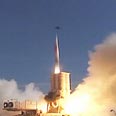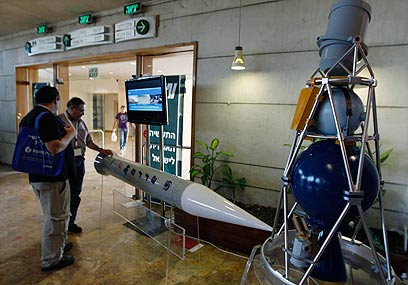
Arrow III missile test (archives)
Eyeing Iran, Israel slates missile shield for 2015
Production schedule of defense network combining rocket interceptors, kamikaze satellites corresponds to Israel's assessment of when Iran might develop nuclear weaponry. Project director: We are talking about hermetic protection
Israel's multi-layered air defense network will be fully deployed by 2015, combining short-range rocket interceptors with kamikaze satellites that blow up ballistic missiles in space, officials said on Monday.
Unveiled at a government-sponsored aerospace conference in Jerusalem, the production schedule corresponds to Israel's assessment of when Iran might develop nuclear weaponry.
Should the Islamic republic get the bomb, which could embolden allies Syria and Lebanese and Palestinian guerrillas in their own fights against the Jewish state.
"In the next two to five years, we will turn this vision into a reality," Colonel Zvika Haimovitch of the Israeli air defense corps said in a speech. "Within the coming five years, we will see this doctrine implemented."
Spurred by Hezbollah salvoes in the 2006 Lebanon war, Israel developed Iron Dome, which shoots down rockets with ranges of 5 to 70 km (3 to 45 miles). David's Sling, an interceptor for more powerful rockets, should be ready by 2013, Haimovitch said.
The next tier of the shield is Israel's Arrow interceptor, which has been operational for a decade and is designed to knock out Iranian or Syrian ballistic missiles at high altitudes.

Arrow model at aerospace conference (Photo: Reuters)
An Arrow III upgrade will launch a booster-rigged satellite beyond Earth's atmosphere to collide with the missile, said project director Yoav Turgeman of state-owned Israel Aerospace Industries (IAI).
"We are talking about hermetic protection," Turgeman said. "Even if the new Arrow misses the incoming threat, it will be far enough from Israel's borders to allow for a secondary interception."
'Enemy has achieved aerial supremacy'
Turgeman said Arrow III, which like its predecessors is being underwritten by the United States, would be ready by 2014 or 2015. Its first live trial is expected in 2011. The projected cost of each interceptor missile is $2 million to $3 million.
Arrow III had previously been swathed in secrecy. Asked about the decision to go public with it at the International Aerospace Conference and Exhibition, an Israeli defense official said: "Everything was done with the full backing and initiative of the Defense Ministry, given the current state of affairs."
He appeared to be referring to Iran's uranium enrichment in defiance of international pressure to curb the process, which can produce fuel for bombs. Tehran says it is for energy only.
Though the Israelis have hinted they could attack Iran pre-emptively, there are big tactical and diplomatic hurdles.
The missile shield -- which officials envisage patching in, when needed, to US interceptors such as Aegis -- suggests Israel is weighing a more defensive posture, girded with the deterrence offered by its own assumed atomic arsenal.
Among the advantages of Arrow III cited by Turgeman was that its interception of a nuclear missile would not produce toxic debris, as this would burn up on re-entering Earth's atmosphere. Such planning is hard to reconcile with Israel's vow, dating back decades, to deny its enemies access to nuclear weaponry.
Arrow veteran Uzi Rubin raised another possible disincentive to a pre-emptive Israeli attack now: retaliation by Iran, Syria, Hezbollah and Palestinian Hamas guerrillas from Gaza.
In the absence of reliable air defenses, Rubin said in a speech, Israeli cities can be hit by as many as 13,000 rockets and missiles, some accurate to within 500 meters (yards) and carrying warheads with as much as a half-ton of explosives.
The greater Tel Aviv area alone could expect to suffer 1,500 strikes -- enough to guarantee damage to military headquarters, paralyze the economy and gut morale. Dozens of Iraqi Scud missiles sowed chaos in Tel Aviv during the 1991 Gulf war.
Rubin said the face-off risked forcing a de facto parity on Israel, which has long relied on overwhelming force of arms to compensate for its geographical smallness and numerous foes.
"The enemy has achieved aerial supremacy without even having planes," Rubin said.
- Follow Ynetnews on Facebook










